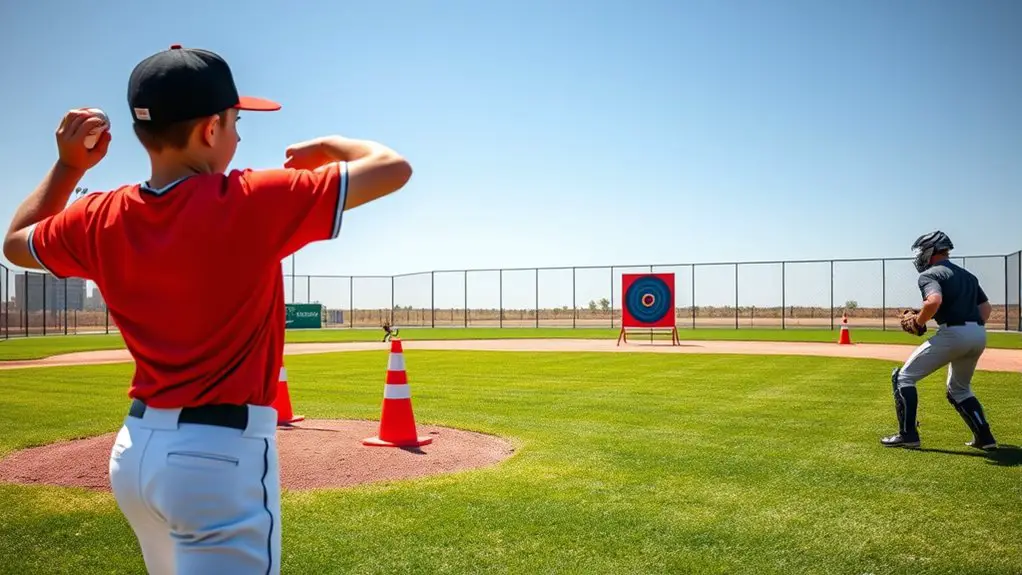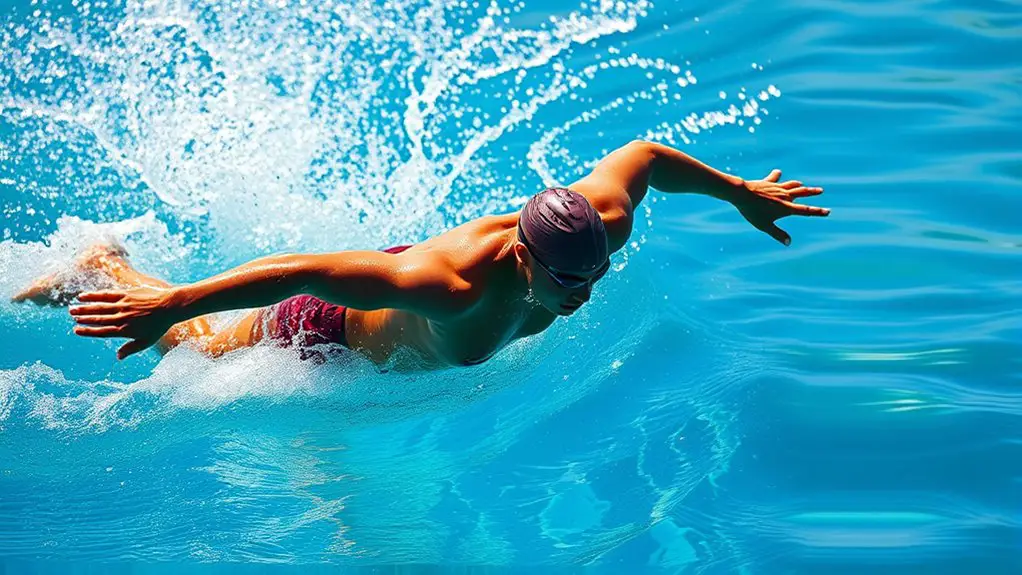To improve your pitching control and accuracy, focus on drills like the Balance Drill for Stability, which enhances core engagement, and Target Practice with a Strike Zone Mat to visualize your targets. Incorporating the One-Knee Drill helps refine your mechanics, while weighted ball drills build strength. Don't forget to use visualization techniques and track progress with technology for feedback. Stick to a consistent routine, and you'll see significant improvements as you practice further.
Understanding the Importance of Pitching Control
When it comes to baseball, mastering pitching control isn't just a skill—it's essential for success on the mound. You know that the importance of accuracy can't be overstated. Every pitch you throw has the potential to sway the game, and a lack of control can lead to walks or home runs that could cost you dearly. Think about how your performance is impacted when you're consistently hitting your target. It boosts your confidence, keeps batters guessing, and allows you to dictate the rhythm of the game.
Without precise control, you're at the mercy of the opposing team, and that's not the freedom you're after. By honing your pitching accuracy, you're not just improving your own game; you're giving your entire team a chance to shine. So, focus on those drills that elevate your control, and watch how your performance transforms on the field.
The Balance Drill for Stability
To improve your pitching stability, the Balance Drill is essential. You'll focus on proper foot placement, engage your core effectively, and maintain your visual target. These elements work together to boost your control on the mound.
Foot Placement Techniques
Mastering foot placement techniques is essential for achieving pitching stability, and one effective method is the Balance Drill. This drill helps you find your ideal foot placement for best pitch balance. Here's a quick overview of how to practice it effectively:
| Step | Action | Focus |
|---|---|---|
| 1 | Stand on one leg | Balance and control |
| 2 | Raise your throwing arm | Arm positioning |
| 3 | Hold for 10 seconds | Stability |
| 4 | Switch legs and repeat | Consistency |
Core Engagement Importance
Core engagement plays an essential role in achieving stability and control during pitching. To harness that power, focus on core stability through strength training. Here's how you can enhance your core engagement:
- Plank Holds: Maintain a strong plank position, feeling the tension in your core.
- Russian Twists: Sit on the ground and twist your torso side-to-side, activating your obliques.
- Single-Leg Balance: Stand on one leg, keeping your core tight to maintain balance.
- Medicine Ball Throws: Engage your core as you throw a medicine ball against a wall, improving rotational strength.
Integrating these drills into your routine will not only boost your pitching accuracy but also give you the freedom to express your natural throwing motion.
Visual Target Focus
How can focusing on a visual target enhance your pitching stability? By honing your visual tracking skills, you can create a clearer connection between your mind and body during your pitch. When you align your target effectively, it brings a sense of freedom and focus to your throw. To practice this, set up a target at various distances and angles. As you pitch, concentrate on that target, allowing your body to respond naturally, promoting better balance and control. You'll find that with consistent practice, your accuracy improves markedly. Remember, it's not just about throwing hard; it's about aligning with your visual target and allowing your instincts to take over, leading to more confident and controlled pitches.
Target Practice With a Strike Zone Mat
While you work on improving your pitching control, using a strike zone mat can be an effective tool for focused target practice. This mat helps you visualize the strike zone, enhancing your target accuracy. Here's how to make the most of it:
- Set Up the Mat: Place the mat on the ground where you typically pitch, ensuring it's aligned with the strike zone.
- Choose Your Targets: Use different sections of the mat to represent various pitch locations—inside, outside, high, and low.
- Vary Your Pitches: Throw a mix of fastballs, curveballs, and sliders to hit each target, challenging yourself with every pitch.
- Track Your Success: Keep a record of how often you hit each target to gauge improvement over time.
The Weighted Ball Drill for Strength
If you're looking to enhance your pitching strength, incorporating the weighted ball drill into your routine can be a game-changer. This drill focuses on building muscle and improving your throwing power, giving you that extra edge on the mound. By using a weighted ball, you can engage your arm and shoulder muscles more intensely than with a regular baseball.
Start by warming up properly, then throw the weighted ball with your normal mechanics, focusing on maintaining good form. This isn't just about raw power; it's strength training that helps improve your control as well. Gradually increase the weight of the ball as you become more comfortable, but always prioritize your technique over throwing harder. Regularly incorporating this drill into your practice can lead to noticeable improvements in your pitching strength, helping you gain the confidence you need to dominate the game.
The One-Knee Drill for Mechanics
After building strength with the weighted ball drill, it's time to focus on refining your mechanics with the one-knee drill. This drill hones your one-knee mechanics, helping you find your rhythm and accuracy without the distractions of a full windup. Here's how to make the most of it:
- Knee Position: Start on your throwing knee, feeling grounded.
- Target Focus: Set your sights on a target, letting your mind visualize the pitch's trajectory.
- Arm Motion: Practice your throwing motion slowly, ensuring your arm stays aligned and your follow-through is smooth.
- Drill Variations: Experiment with different pitches—fastballs, changeups, or breaking balls—to keep it fresh and challenging.
Embrace this drill as a pathway to freedom in your pitching. By mastering your mechanics, you'll gain the confidence to release your full potential on the mound. Remember, incorporating positive self-talk into your practice can significantly enhance your performance by boosting your confidence and focus.
Incorporating Visualization Techniques
To sharpen your pitching control, incorporating visualization techniques can be a game changer. By practicing mental imagery, focused breathing, and pre-pitch visualization, you can enhance your concentration and confidence on the mound. Additionally, visualization can boost confidence and reduce anxiety, allowing you to perform at your best during crucial moments. Let's explore how these methods can transform your approach to pitching.
Mental Imagery Practices
While many pitchers focus on physical drills to improve their control, incorporating mental imagery practices can be equally transformative. By engaging in mental rehearsal, you can sharpen your focus and enhance your performance on the mound. Here are some effective imagery techniques to try:
- Visualize the perfect pitch – Picture the ball gliding effortlessly through the strike zone.
- Imagine your ideal stance – See yourself poised and ready, exuding confidence.
- Create a mental highlight reel – Replay moments of success, feeling the joy of each strike.
- Envision the crowd's reaction – Hear the cheers as you dominate the game.
Embrace these techniques, and you'll find yourself not just throwing, but truly owning the field.
Focused Breathing Exercises
Control is essential for any pitcher, and incorporating focused breathing exercises can greatly enhance your performance. By practicing focused breathing, you'll not only improve your concentration but also achieve significant stress reduction. Start by finding a quiet space where you can close your eyes and take deep, calming breaths. Inhale deeply through your nose, filling your lungs, then exhale slowly through your mouth. Visualize each breath as a wave washing away tension, allowing your mind to clear. As you breathe, picture yourself on the mound, feeling relaxed and in control. This simple yet powerful technique helps ground you, setting the stage for improved accuracy and control. Make focused breathing a regular part of your routine, and watch your pitching game transform.
Pre-Pitch Visualization Techniques
Many pitchers find that pre-pitch visualization techniques can greatly enhance their performance on the mound. Engaging in visualization exercises helps you mentally prepare for each pitch, creating a vivid picture of success. Here are four effective techniques to incorporate into your routine:
- Picture the Target: Visualize the exact spot you want the ball to hit.
- Imagine the Pitch: See the ball's movement in your mind, from your hand to the plate.
- Feel the Energy: Sense the rhythm and energy in your body as you prepare to pitch.
- Celebrate Success: Picture yourself striking out the batter, feeling the thrill of accomplishment.
The Bullpen Session Strategy
A well-structured bullpen session can be a game-changer for improving your pitching control. It's not just about throwing; it's about focusing your bullpen strategy to maximize your effectiveness. Start by selecting specific pitching drills that target accuracy and consistency. For instance, use targets or cones to hone in on your precision, challenging yourself to hit those spots consistently.
Consider breaking your session into segments—warm-up, drills, and situational pitches. This approach allows you to concentrate on different aspects of your delivery, which can free you from bad habits. Remember to incorporate a variety of pitches, testing your command over each.
Lastly, stay relaxed and enjoy the process. Your bullpen should feel liberating, not constraining. When you embrace this strategy, you'll find that your control improves, setting you up for success when it counts.
Using Technology for Feedback
Incorporating technology into your training can take your pitching control to the next level. By utilizing modern tools, you can create effective feedback loops that help you refine your skills through data analysis. Here are four ways to leverage technology for better pitching accuracy:Utilizing technology in your training enhances pitching precision through data-driven feedback and skill refinement.
- Video Analysis: Record your pitching sessions to review your mechanics and pinpoint areas for improvement.
- Radar Guns: Track your pitch speed and identify any inconsistencies in your throwing velocity.
- Pitch Tracking Apps: Use apps that provide real-time feedback on your pitch location and movement.
- Wearable Sensors: Equip yourself with devices that monitor your arm angle and release point.
Creating a Consistent Routine
While developing your pitching control, creating a consistent routine is essential for honing your skills. A solid practice schedule not only helps you stay organized but also builds routine consistency, allowing you to focus on specific drills that enhance your accuracy. Start by setting aside dedicated time each day or week for pitching practice. This commitment keeps you accountable and helps you develop muscle memory.
Incorporate a variety of drills into your routine, mixing up long toss, target practice, and game-like scenarios. This variety prevents boredom and keeps you engaged. Pay attention to your body; if you need a day to recover, don't hesitate to adjust your schedule. Remember, it's about quality over quantity—focus on making each session count. By sticking to your routine, you'll cultivate the confidence and control that'll take your pitching to the next level. Embrace this freedom to explore your skills!
Frequently Asked Questions
How Often Should I Practice Pitching Control Drills?
When it comes to perfecting your pitching prowess, practice frequency is key. You should weave pitching control drills into your daily routine—aim for at least three to five times a week. This consistent commitment cultivates confidence and consistency. Mix things up to keep it fresh and fun. Remember, it's all about finding that freedom in your flow; the more you practice, the more natural it'll feel when you're on the mound!
What Age Is Appropriate to Start These Drills?
It's never too early to start focusing on pitching control drills, but around age 8 is often ideal for youth development. At this age, kids can grasp basic mechanics and begin skill progression. You want to create a fun, encouraging environment where they can explore their abilities without pressure. As they grow, you can gradually introduce more advanced drills, helping them develop confidence and mastery over their pitching skills.
Can I Do These Drills Indoors?
Imagine perfecting your pitch while the rain pours outside, keeping you indoors. You can absolutely do indoor pitching accuracy drills! They're not just practical, but they also give you the freedom to train anytime. Just grab a soft ball and set up a target in your living room or garage. With some creativity, you can turn any space into your personal training ground. So, don't let the weather hold you back from honing your skills!
How Long Should Each Practice Session Last?
When it comes to practice sessions, the ideal session duration is typically around 30 to 60 minutes. This timeframe allows you to focus without feeling overwhelmed. You should aim for consistent practice frequency, like 3 to 4 times a week, to really see improvement. Remember, it's all about finding what works best for you. Don't hesitate to adjust the duration or frequency based on your energy levels and schedule!
What Equipment Do I Need for These Drills?
For your drills, you'll need a few essential pieces of equipment. First, consider investing in pitching targets; they'll help you focus on your accuracy. Training aids like weighted balls can also enhance your strength and control. You might want a quality glove and a sturdy mound, too. These tools give you the freedom to practice anywhere, making it easier to refine your skills and elevate your game without constraints.




